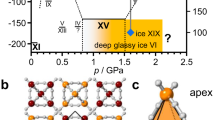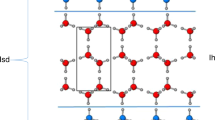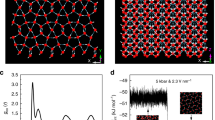Abstract
MUCH of the literature dealing with the dielectric properties of ice1 has used Bjerrum's concepts of D- and L-defects2. A pair of D- and L-defects is formed (Fig. 1) when a water molecule in ice rotates through 120° around one of its O–H … O axes, thus leaving one pair of neighbour O … O atoms with no intervening hydrogen atom (L-defect), and another pair of neighbours O–H … H–O with two hydrogens (D-defect). A subsequent similar rotation of the appropriate molecule adjacent to the L-defect separates these two defects.
This is a preview of subscription content, access via your institution
Access options
Subscribe to this journal
Receive 51 print issues and online access
$199.00 per year
only $3.90 per issue
Buy this article
- Purchase on Springer Link
- Instant access to full article PDF
Prices may be subject to local taxes which are calculated during checkout
Similar content being viewed by others
References
Hasted, J. B., Progress in Dielectrics, 3, 101 (1961).
Bjerrum, N., Science, 115, 385 (1952).
Dunitz, J. D., Nature, 197, 860 (1963).
Hendrickson, J. B., J. Amer. Chem. Soc., 83, 4537 (1961).
Nakamoto, K., Margoshes, M., and Rundle, R. E., J. Amer. Chem. Soc., 77, 6680 (1955).
Zimmerman, J. R., and Pimentel, G. C. (in the press); (private communication).
Author information
Authors and Affiliations
Rights and permissions
About this article
Cite this article
EISENBERG, D., COULSON, C. Energy of Formation of D-Defects in Ice. Nature 199, 368–369 (1963). https://doi.org/10.1038/199368b0
Issue Date:
DOI: https://doi.org/10.1038/199368b0
This article is cited by
-
Valence Defects in Ice
Nature (1964)
Comments
By submitting a comment you agree to abide by our Terms and Community Guidelines. If you find something abusive or that does not comply with our terms or guidelines please flag it as inappropriate.



